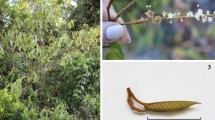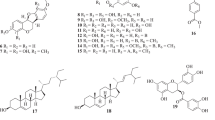Abstract
Two new flavonoids, hydroxybenzyl flavonoid glycosides (6-p-hydroxybenzyl kaempferol-7-O-β-D-glucopyranoside named cudranian 1 and 6-p-hydroxybenzyl quercetin-7-O-β-D-glucopyranoside named cudranian 2), and 3 known flavonoids (kaempferol-7-O-β-D-glucopyranoside, quercetin-7-O-β-D-glucopyranoside and aromadendrin) were isolated from root bark of Cudrania tricuspidata and their structures were elucidated by spectroscopic methods. These compounds showed remarkable radical scavenging effects against 1, 1-diphenyl-2-picrylhydrazyl (DPPH) and anti-lipid peroxidation efficacy on human low-density lipoprotein by TBARS assay.
Similar content being viewed by others
References
Cho, E. J., Yokozawa, T., Rhyu, D. Y., Kim, S. C., Shibahara, N., and Park, J. C., Study on the inhibitory effects of Korean medicinal plants and their main compounds on the 1,1-diphenyl-2-picrylhydrazyl radical. Phytomedicine, 10, 544–551 (2003).
Fujimoto, T. and Nomura, T., Structures of Cudraflavone A, and Euchrestaflavanone C. Heterocycles, 22, 997–1003 (1984).
Fujimoto, T. and Nomura, T., Components of Root Bark of Cudrania tricuspidata; 3. Isolation and Structure Studies on the Flavonoids. Planta Med., 51, 190–193 (1985).
Fujimoto, T., Hano Y., and Nomura, T., Components of Root Bark of Cudrania tricuspidata 1. Structures of Four New Isoprenylated Xanthones, Cudraxathone A, B, C, and D. Planta Med., 50, 218–221 (1985).
Fujimoto, T., Hano Y., Nomura, T., and Uzawa, J., Components of Root Bark of Cudrania tricuspidata 2. Structures of Two New Isoprenylated Flavones, Cudraflavones A and B. Planta Med., 50, 161–163 (1984).
Han, S. Y., Park, J. H., Park, H. J., and Choi, J. S., Chemical Study on the Stem of Cudrania tricuspidata. Arch. Pharm. Res., 12, 39–41 (1989).
Hatano, T., Edamatsu, R., Hiramatus, M., Mori, A., Fujita., Yasuhara, T., Yoshida, T., and Okuda, T., Effects of the Interaction of Tannins with Co-existing Substances. ·μ. Effects of tannins and Related Polyphenols on Superoxide Anion Radical and on 1,1-Diphenyl-2-picrylhydrazyl Radical. Chem. Pharm. Bull., 37, 2016–2021 (1989).
Kang, D. G., Hur, T. Y., Lee, G. M., Oh, H.C., Kwon, T. O., Sohn, E. S., and Lee, H. S., Effects of Cudrania tricuspidata water extract on blood pressure and functions in NOdependent hypertention. Life Sci., 70, 2599–2609 (2002).
Lee, B. W., Lee, J. H., Lee, S. T., Lee H. S., Lee W. S., Jeong, T. S., and Park, K. H., Antioxidant and Cytotoxic activities of Xanthones from Cudrania tricuspidata. Bio. & Med. Chem. Letters, 15, 5548–5552 (2005).
Lee, I. K., Kim, C. J., Song, K. S., Kim, W. M., and Yoo, I. D., Two benzylated dihydroflavonols from Cudrania tricuspidata. J. Nat. Prod., 58, 1614–1617 (1989).
Lee, I. K., Kim, C. J., Song, K. S., Kim, H. M., Koshino, H., Uramoto, M., and Yoo, I. D., Cytotoxic benzyl dihydroflavonols from Cudrania tricuspidata. Phytochemistry, 41, 213–216 (1996).
Markham, K. R., Ternai, B., Stanley, R., Geiger, H., and Mabry, T. J., Carbon-13 NMR studies of flavonoids-III. Tetrahedron, 34, 1387–1397 (1978).
Mizuno, M., Hanioka, S., Suzuki, N., Iinuma, M., Tanaka, T., Shun, L. X., and Du, M. Z., Flavonol glycosides from Epimedium sagittatum. Phyochemistry, 26, 861–863 (1987).
Nomura, T., Hano, Y., and Fujimoto, T., Three new isoprenylate xanthones, cudraxathone A, B, and C from the root barks of Cudrania tricuspidata (Carr.) Bur.. Heterocycles, 20, 213–218 (1983).
Park, K. H., Park, Y. D., Han, J. M., Im, K. R., Lee, B. W., Jeong, I. Y., Jeong, T.S., and Lee, W. S., Anti-atherosclerotic and anti-inflammatory activities of catecholic xanthones and flavonoids isolated from Cudrania tricuspidata. Bio. & Med. Chem. Letters, 16, 5580–5583 (2006).
Sahnhai Science and Technological Publisher, The Dictionary of Chinese Drugs, Shougakukan, Y Tokyo, 2, p. 2383, (1985).
Seo, E. J., Curitis-Long, M. J., Lee, B. W., Kim, H. Y., Ryu, Y. B., Jeong, T. S., Lee, W. S., and Park, K. H., Xanthones from Cudrania Tricuspidata displaying potent α-glucosidase inhibition. Bio. & Med. Chem. Letters, 17, 6421–6424 (2007).
Seo, W. G., Pae H. O., Oh, G. S., Chai, K. Y., Yun, Y. G., Kwon, T. O., and Chung H. T., Inhibitory effect of ethyl acetate fraction from Cudrania tricuspidata. On the expression of nitric oxide syntheses gene in RAW 264.7 macrophages stimulated with interferon-γ and lipopolysaccharide. Gen. Pharmacol.-Vasc. S., 35, 21–28 (2000).
Shen, Z. and Theander, O., Flavonoid Glycosides from Needles of Pinus Massoniana. Phytochemistry, 24, 155–158 (1985).
Stephen, J. P., Louise, N. J., and David, C. P., High-resolution 1H-and 13C-NMR Spectra of D-glucopyranose, 2-acetoamino-2-deoxy-D-glucopyranose, and related compounds in aqueous media. Carbohydrate Research, 59, 19–34 (1997)
Tian, Y. H., Kim, H. C., Cui, J. M., and Kim, Y. C., Hepatoprotective Constituents of Cudrania tricuspidata. Arch. Pharm. Res., 28(1), 44–48 (2005).
Zheng, Z. P., Liang, J. Y., and Hu, L. H., Water-soluble constituents of Cudrania tricuspidata (Carr.) Bur. J. inter. Plant Biol., 48(8), 996–1000 (2006).
Zou, Y., Hou, A., Zhu, G., Chen, Y., Sun, H., and Zhao, Q., Cytotoxic isoprenylated xanthones from Cudrania tricuspidata. Bioorg. Med. Chem., 12(8), 1947–1953 (2004).
Author information
Authors and Affiliations
Corresponding author
Rights and permissions
About this article
Cite this article
Lee, Y.J., Kim, S., Lee, S.J. et al. Antioxidant activities of new flavonoids from Cudrania tricuspidata root bark. Arch. Pharm. Res. 32, 195–200 (2009). https://doi.org/10.1007/s12272-009-1135-z
Received:
Revised:
Accepted:
Published:
Issue Date:
DOI: https://doi.org/10.1007/s12272-009-1135-z




